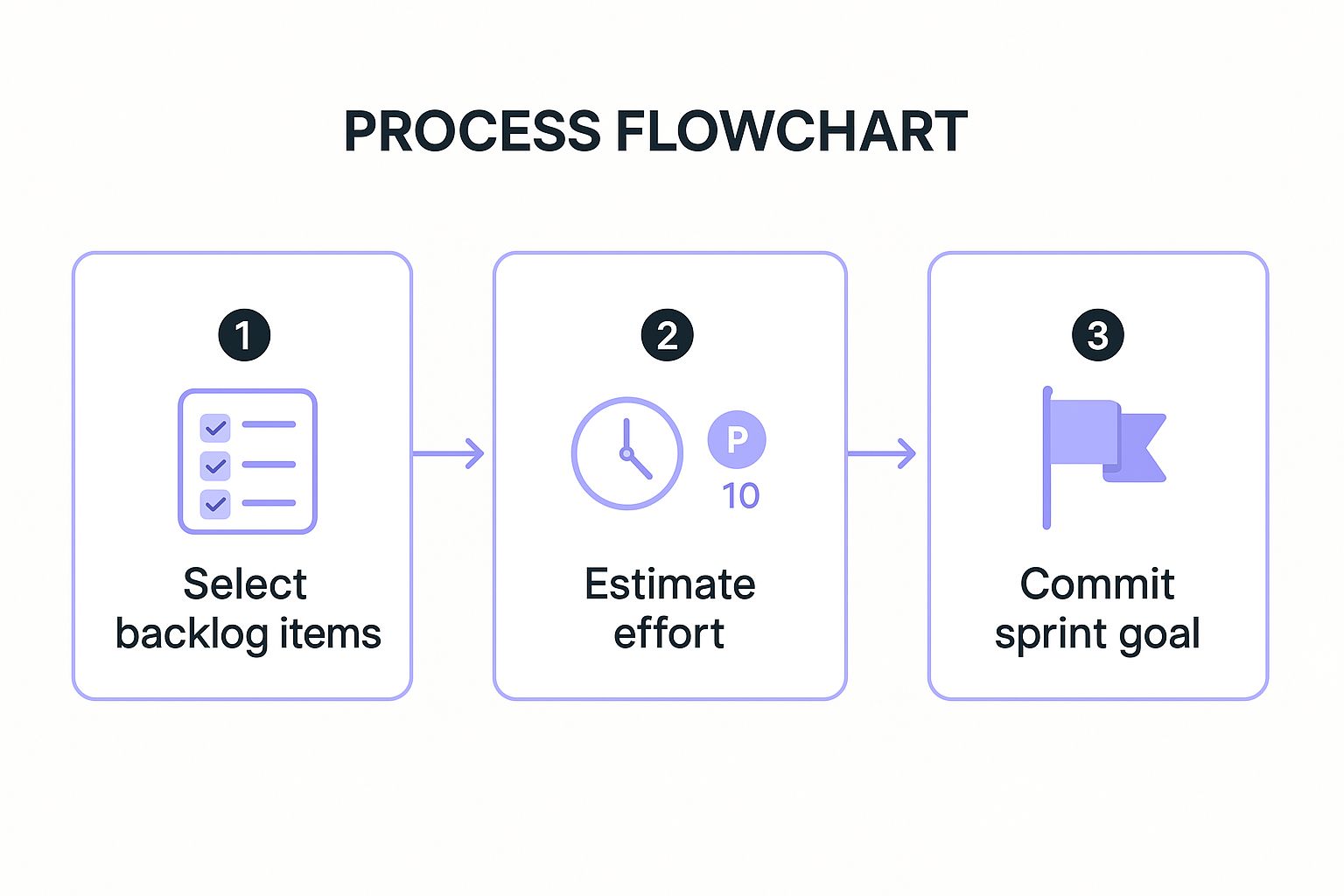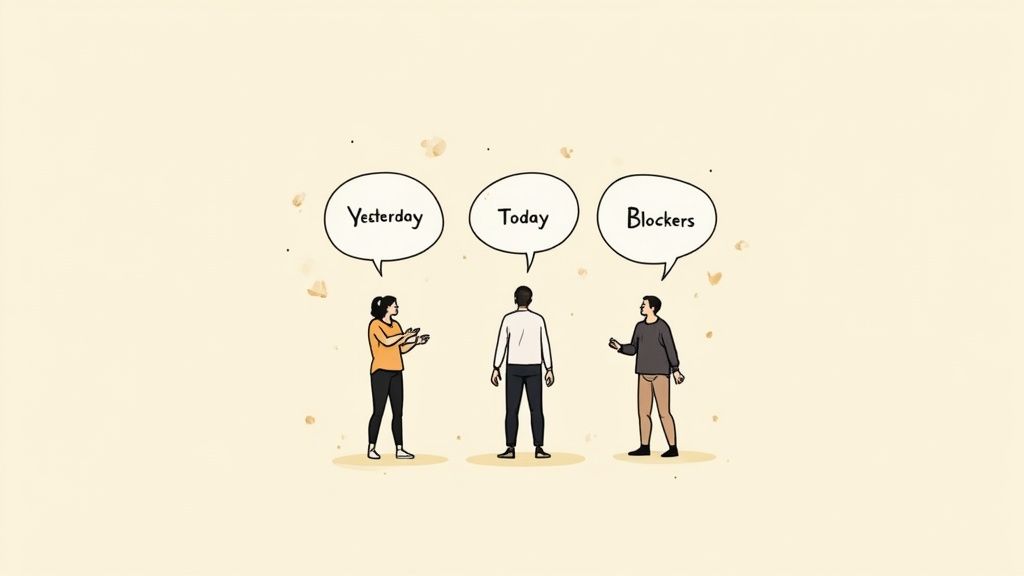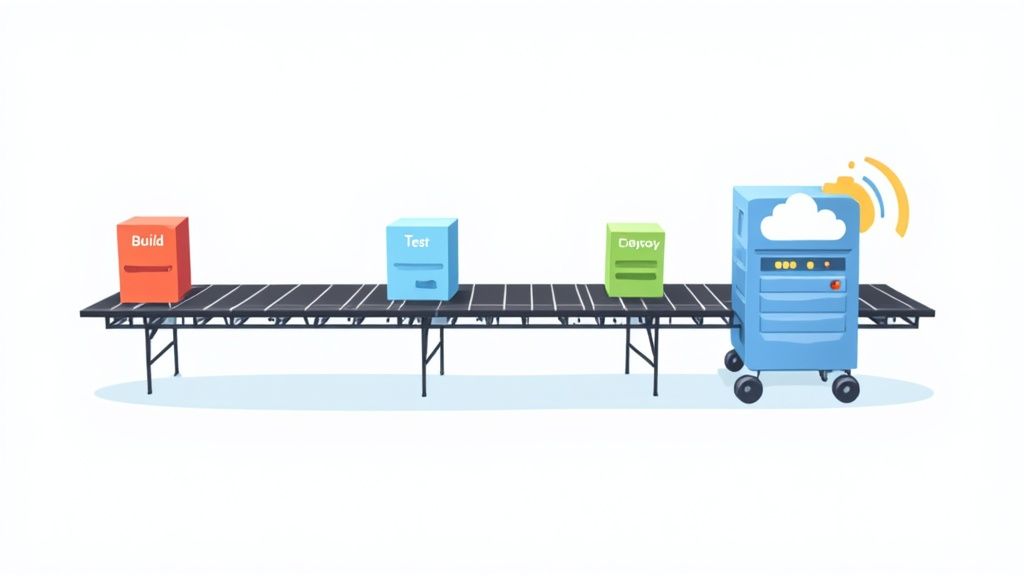
Let's be honest. Adopting 'Agile' often feels like you've been handed a box of IKEA furniture with half the instructions missing and the Allen key replaced by a motivational poster. You're told it will be faster, better, more collaborative. Next thing you know, your 'daily stand-ups' are hour-long status reports where everyone stares at their shoes, and your backlog is a bottomless pit of forgotten dreams.
I've been there. I've seen teams mortgage their office ping-pong table for another 'Agile transformation' consultant who speaks only in acronyms. It’s painful. The good news? You don't need a PhD in buzzwords to make this work. You just need a few non-negotiable practices that separate the teams that ship from the teams that just… meet.
This isn't textbook theory. This is a list of battle-tested, founder-approved agile methodology best practices we've seen deliver results, time and time again. We’ll cover everything from running sprint planning that actually works to creating a "Definition of Done" that isn't just a vague wish. Consider this the user manual the Agile Manifesto forgot to give you. Let's get into it.
Sprint Planning is the ceremony that kicks off every sprint, and frankly, it’s where most teams either win or lose the next few weeks. This isn’t just about grabbing tasks off a backlog; it’s a strategic huddle where the team commits to a realistic, valuable goal. A sprint is a fixed, time-boxed period, typically one to four weeks, where your team focuses exclusively on delivering a usable product increment.
Think of it as a mini-project with a clear finish line. Salesforce uses tight three-week sprints with detailed capacity planning to ensure their delivery is predictable. On the flip side, Spotify often runs one-week sprints to iterate and gather user feedback at lightning speed. The key is consistency; pick a length and stick with it to build a reliable team rhythm. Otherwise, you're just guessing.

This sequence ensures the team moves from a broad backlog to a focused, actionable commitment for the upcoming sprint. Simple, right?
The Daily Stand-up, or Daily Scrum, is the 15-minute heartbeat of an agile team. It’s not a status report for the manager; it’s a tactical sync-up for the team, by the team. This quick huddle is where you find out who’s stuck, who needs help, and whether you're still on track to meet the sprint goal. Ignore this ceremony, and you'll find small roadblocks turning into week-long traffic jams.
This meeting’s power comes from its relentless consistency. Google famously uses walking stand-ups to keep the energy high and the meeting brief. Atlassian, naturally, runs its virtual stand-ups through Jira, keeping distributed teams aligned. The goal is simple: synchronize, identify impediments, and get back to work. It’s the daily dose of reality every team needs to stay honest about their progress.

This quick, daily sync prevents minor issues from derailing the entire sprint, fostering a culture of mutual support and transparency.
If you're still manually merging code and deploying with your fingers crossed, you're living in the dark ages. Continuous Integration and Continuous Deployment (CI/CD) is the automated engine that powers modern agile teams. It’s a practice where every code change is automatically built, tested, and pushed into production, turning your release cycle from a quarterly nightmare into a daily non-event. This is one of those agile methodology best practices that separates the talkers from the doers.
Think of it as an assembly line for your software. Amazon famously deploys code every 11.7 seconds, not because their engineers are superhuman, but because their CI/CD pipeline is flawless. Similarly, Netflix leverages its Spinnaker platform for rock-solid multi-cloud deployments, ensuring that a bad push doesn't take down your weekend binge-watch. This isn’t just for giants; it’s a critical practice for any team that wants to move fast without breaking things.

Automating this flow eliminates human error and dramatically shortens the feedback loop, allowing your team to focus on building features instead of managing deployments.
The Sprint Retrospective is where the real magic of agile happens. It’s not a complaint session or a group hug; it’s a focused, no-blame autopsy of your last sprint. Held after the Sprint Review, this meeting is the team’s chance to inspect itself and create a plan for improvements. Without it, you're not doing agile; you're just doing work in two-week chunks and hoping for the best.
This isn't about pointing fingers. It’s about systemic improvement. Airbnb, for example, uses the "Rose, Bud, Thorn" format to identify positives, new ideas, and challenges. Spotify empowers its squads to run their own retrospectives and create small, trackable experiments for the next sprint. The goal is to exit the meeting with a concrete plan, not just a list of grievances. It’s the engine of continuous improvement, turning real-world failures into future wins.
The retrospective ensures your team evolves, adapting its processes to become more effective. It's the core of what makes agile methodology best practices so powerful.
User stories are the antidote to building features nobody asked for. Instead of a sterile list of technical requirements, they frame work from the end-user's perspective using a simple format: "As a [user type], I want [functionality] so that [benefit]." This isn't just a semantic trick; it forces the entire team to think about why they are building something, not just what. It’s a core practice in any list of agile methodology best practices because it anchors development to genuine user value.
This shift in focus ensures you're solving real problems. Atlassian, for instance, embeds detailed acceptance criteria directly into Jira user stories, leaving no room for ambiguity. Similarly, Airbnb uses story mapping to visualize the entire customer journey, ensuring each individual story contributes to a cohesive, positive experience. The goal is to move from a feature factory to a value-delivery engine.
As a [user type/persona],
I want to [perform some action/goal],
So that I can [achieve some outcome/benefit].
This format ensures that every piece of work is directly tied to a tangible user benefit, preventing scope creep and wasted effort.
Forget the old-school assembly line where work gets tossed over the wall from design to dev to QA. That’s a recipe for delays, misunderstandings, and a final product nobody recognizes. Cross-functional teams are the antidote, embedding all the skills needed to ship a feature (development, testing, design, business analysis) into one self-organizing unit. They own the work from concept to completion.
Think of it as your own mini-startup focused on a single goal. Amazon famously built its empire on "two-pizza teams," small, autonomous groups with every skill needed to operate their service. Similarly, ING Bank completely restructured its organization into cross-functional "squads" and "tribes" to eliminate departmental silos and accelerate innovation. The goal is to stop handoffs and start collaborating.
This model is a core tenet of agile methodology best practices because it builds collective ownership and dramatically reduces dependencies. When your team can solve its own problems without waiting for another department, you move faster and build better products.
Your product backlog isn't a "to-do" list; it's the living, breathing roadmap for your entire product. If you treat it like a feature dumping ground, you’ll end up building a product nobody wants. Effective backlog management is the art of continuously refining and prioritizing a dynamic list of features, fixes, and improvements based on real business value, not just the loudest voice in the room.
It’s the single source of truth that guides the development team. Microsoft, for instance, uses Azure DevOps to maintain an exhaustive and meticulously prioritized backlog, ensuring engineering efforts align directly with strategic goals. Similarly, Slack famously integrates user feedback directly into its backlog prioritization process, letting customer needs steer the ship. The goal is to make your backlog a strategic asset, not an administrative burden, which is a key part of implementing agile methodology best practices.
Building in a vacuum is the fastest way to build something nobody wants. Iterative feedback is the agile practice of pulling your customers into the development loop early and often, ensuring you’re building with them, not just for them. This isn't about a single focus group; it's a continuous conversation that validates your direction at every turn.
Think about it: Dropbox famously used a simple demo video to test its core concept before a single line of code was perfected, validating massive market demand. Buffer used simple landing pages to test new feature ideas. This constant pulse-check is what separates products that customers love from features that just collect dust. It’s one of the most critical agile methodology best practices for de-risking your roadmap.
The Definition of Done (DoD) is the team's single source of truth for what "complete" actually means. It’s a shared checklist that prevents the dreaded "it works on my machine" conversation. Without a DoD, you’re just shipping half-baked features and creating technical debt. This isn't just a list of tasks; it’s a commitment to quality that ensures consistency and transparency.
A solid DoD is the difference between controlled, predictable delivery and chaotic guesswork. For example, GitLab has a public DoD that includes everything from code style checks to security reviews, leaving zero room for ambiguity. Similarly, Etsy’s DoD often includes performance benchmarks, ensuring new features don’t just work, but work well under load. This practice is a cornerstone of agile methodology best practices, turning a subjective concept into an objective measure of progress.
Think of it as your team’s quality contract. It’s a formal agreement that a user story must meet before it can be considered shippable.
| Practice/Method | Implementation Complexity | Resource Requirements | Expected Outcomes | Ideal Use Cases | Key Advantages |
|---|---|---|---|---|---|
| Sprint Planning and Execution | Medium; requires disciplined team and process adherence | Team velocity data, planning tools | Predictable delivery rhythm; controlled scope | Projects needing incremental delivery and regular reviews | Better estimation, natural checkpoints, scope control |
| Daily Stand-ups (Daily Scrums) | Low; brief daily meetings with fixed structure | Whole team participation, facilitation | Improved communication and quick blocker resolution | Teams needing daily alignment and impediment removal | Enhances transparency, team accountability, fast issue ID |
| Continuous Integration & Deployment (CI/CD) | High; tooling setup and automated testing required | CI/CD platforms, automated test suites | Faster feedback, higher deployment frequency, reduced integration risks | Software projects demanding frequent releases and high reliability | Early bug detection, deployment automation, improved quality |
| Retrospective Meetings | Medium; requires skilled facilitation and time commitment | Facilitator, time for meetings | Continuous process improvement and team trust | Teams committed to adaptive improvement cycles | Builds psychological safety, identifies systemic issues |
| User Story Creation and Management | Low-Medium; requires writing skill and stakeholder collaboration | Product Owner, stakeholders | Clear, user-focused requirements and flexible scope | Agile projects focused on user value delivery | Improves communication, maintains user value focus, flexible scope |
| Cross-functional Team Collaboration | High; cultural change and diverse staffing needed | Diverse skill set, collaboration tools | Faster problem-solving, improved quality through diversity | Projects needing broad skill input and reduced handoffs | Reduces delays, increases knowledge sharing, enhances innovation |
| Product Backlog Management | Medium; requires ongoing prioritization and grooming | Skilled Product Owner, stakeholder involvement | Clear priorities, aligned stakeholder expectations | Dynamic and evolving product development environments | Supports flexible scope, stakeholder alignment, data-driven decisions |
| Iterative Feedback & Customer Involvement | Medium; requires customer engagement and feedback mechanisms | Access to customers, demo tools, feedback channels | Reduced risk of building unwanted features, improved product-market fit | Products needing continuous validation and user input | Early course correction, stronger customer relationships |
| Definition of Done (DoD) | Low-Medium; requires team agreement and upkeep | Team consensus, documentation maintenance | Consistent quality, reduced technical debt | Teams aiming for clear quality standards and transparency | Ensures quality, reduces ambiguity, improves planning accuracy |
So, there you have it. A full playbook of agile methodology best practices, from mastering your daily stand-ups to defining what "done" actually means. We've walked through sprint planning, CI/CD pipelines, and the art of the retrospective. But let's be honest, reading this list won't magically transform your team overnight. Hope you weren't expecting a silver bullet, because there isn't one.
Agile isn't a checklist you complete or a certification you hang on the wall. It’s a muscle. You build it through reps, consistency, and a healthy dose of self-awareness. It's about having the guts to admit in a retrospective that the last sprint was a dumpster fire and then having the discipline to fix what broke. The real secret isn't just doing Agile; it’s about creating a culture that is genuinely agile.
Don't let this just be another tab you close. Pick one, just one, of these practices to focus on improving this month.
The goal is incremental progress, not immediate perfection. These frameworks are tools, not scripture. You have to adapt them to fit your team's unique DNA, your specific product, and your market's demands. True agility is knowing when to stick to the rules and when to intelligently break them. That’s the hard part, and it’s where most teams stumble.
Ultimately, mastering these agile methodology best practices comes down to one non-negotiable ingredient: the right people. You can have the best processes in the world, but they're useless without a team that has the mindset to execute them. You need people who thrive on feedback, communicate proactively, and are obsessed with delivering value, not just closing tickets.
And when you're ready to scale that team with talent that already gets it? Well, you could spend your afternoons fact-checking resumes and running technical interviews. Or, you could find pre-vetted, elite professionals ready to integrate seamlessly. The right people make any practice ten times more effective.
Now go make something great.
